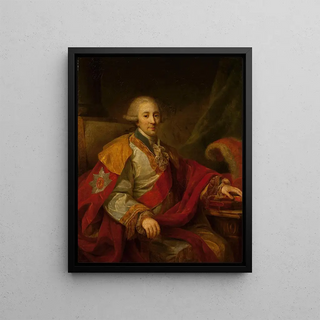Art print | Portrait of a dignitary - Johann Baptist von Lampi the Elder


View from behind

Frame (optional)
Johann Baptist von Lampi l'Ancien’s "Art print of a Dignitary Portrait" is much more than a simple depiction of a man in formal attire. This piece, which immerses the viewer in the 18th-century universe, serves as a true window into an era where nobility and power intertwined with culture and art. Through this portrait, Lampi succeeds in capturing not only the physical features of his subject but also his essence, status, and influence. The richness of details and the depth of colors invite prolonged contemplation, revealing the subtleties of the dignitary's personality while offering a glimpse into the society of his time.
Style and uniqueness of the work
Johann Baptist von Lampi l'Ancien’s style is characterized by striking realism and meticulous attention to detail. In the "Art print of a Dignitary Portrait," one can observe exceptional mastery of light and shadow play, which gives an almost sculptural dimension to the character's features. The drapery of his attire, finely rendered, seems almost tangible, while the background, often understated, highlights the subject without ever diverting attention. The color palette chosen by the artist, oscillating between warm tones and cooler shades, creates an atmosphere that is both solemn and intimate. Every element of the composition, whether it be accessories or facial expressions, contributes to telling a story—the story of a man whose status is both respected and revered.
The artist and his influence
Johann Baptist von Lampi l'Ancien, born in 1751, is an emblematic figure of Austrian portraiture. Trained in the workshops of the great masters of his time, he developed a style that combines tradition and innovation. Lampi was not only influenced by neoclassical painting techniques but also integrated elements of emerging Romanticism, which allowed him to stand out in a constantly evolving artistic landscape. His work had a significant impact on his contemporaries and inspired many artists who followed in his footsteps. By capturing the very essence of his subjects, he contributed

Matte finish

View from behind

Frame (optional)
Johann Baptist von Lampi l'Ancien’s "Art print of a Dignitary Portrait" is much more than a simple depiction of a man in formal attire. This piece, which immerses the viewer in the 18th-century universe, serves as a true window into an era where nobility and power intertwined with culture and art. Through this portrait, Lampi succeeds in capturing not only the physical features of his subject but also his essence, status, and influence. The richness of details and the depth of colors invite prolonged contemplation, revealing the subtleties of the dignitary's personality while offering a glimpse into the society of his time.
Style and uniqueness of the work
Johann Baptist von Lampi l'Ancien’s style is characterized by striking realism and meticulous attention to detail. In the "Art print of a Dignitary Portrait," one can observe exceptional mastery of light and shadow play, which gives an almost sculptural dimension to the character's features. The drapery of his attire, finely rendered, seems almost tangible, while the background, often understated, highlights the subject without ever diverting attention. The color palette chosen by the artist, oscillating between warm tones and cooler shades, creates an atmosphere that is both solemn and intimate. Every element of the composition, whether it be accessories or facial expressions, contributes to telling a story—the story of a man whose status is both respected and revered.
The artist and his influence
Johann Baptist von Lampi l'Ancien, born in 1751, is an emblematic figure of Austrian portraiture. Trained in the workshops of the great masters of his time, he developed a style that combines tradition and innovation. Lampi was not only influenced by neoclassical painting techniques but also integrated elements of emerging Romanticism, which allowed him to stand out in a constantly evolving artistic landscape. His work had a significant impact on his contemporaries and inspired many artists who followed in his footsteps. By capturing the very essence of his subjects, he contributed






